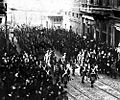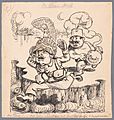Turkish War of Independence facts for kids
Quick facts for kids Turkish War of Independence |
|||||||||
|---|---|---|---|---|---|---|---|---|---|
| Part of the Revolutions of 1917–1923 in the aftermath of World War I |
|||||||||
 Clockwise from top left: Delegation gathered in Sivas Congress to determine the objectives of the Turkish National Movement; Turkish civilians carrying ammunition to the front; Kuva-yi Milliye infantry; Turkish horse cavalry in chase; Turkish Army's capture of Smyrna; troops in Ankara's Ulus Square preparing to leave for the front. |
|||||||||
|
|||||||||
| Belligerents | |||||||||
|
Turkish Nationalists: Supported by:
(1919–1920) (from 1921) |
Entente: (in 1920) (in 1921) Seperatists:
|
||||||||
| Commanders and leaders | |||||||||
| Strength | |||||||||
November 1920: 86,000 (creation of regular army) August 1922: 271,000 |
1922: 200,000–250,000 |
||||||||
| Casualties and losses | |||||||||
22,690 died of disease 5,362 died of wounds or other non-combat causes 35,000 wounded 7,000 prisoners |
18,095 missing 48,880 wounded 4,878 died outside of combat 13,740 prisoners 3,000+ prisoners |
||||||||
| 264,000 Greek civilians killed 60,000–250,000 Armenian civilians killed 15,000+ Turkish civilians killed in the Western Front 30,000+ buildings and 250+ villages burnt to the ground by the Hellenic Army and Greek/Armenian rebels. |
|||||||||
|
Notes
|
|||||||||
The Turkish War of Independence (19 May 1919 – 24 July 1923) was a series of military campaigns waged by the Turkish National Movement after parts of the Ottoman Empire were occupied and partitioned following its defeat in World War I. These campaigns were directed against Greece in the west, Armenia in the east, France in the south, loyalists and separatists in various provinces, and British and Ottoman troops around Constantinople (Istanbul). They happened concurrently with other resistance movements against the partitioning of the Ottoman Empire.
While World War I ended for the Ottoman Empire with the Armistice of Mudros, the Allied Powers continued occupying and seizing land per the Sykes–Picot Agreement, as well as to prosecute former members of the Committee of Union and Progress and those involved in the Armenian genocide. Ottoman military commanders therefore refused orders from both the Allies and the Ottoman government to surrender and disband their forces. This crisis reached a head when sultan Mehmed VI dispatched Mustafa Kemal Pasha (Atatürk), a well-respected and high-ranking general, to Anatolia to restore order; however, Mustafa Kemal became an enabler and eventually leader of Turkish nationalist resistance against the Ottoman government, Allied powers, and Christian minorities.
In an attempt to establish control over the power vacuum in Anatolia, the Allies persuaded Greek Prime Minister Eleftherios Venizelos to launch an peacekeeping force into Anatolia and occupy Smyrna (İzmir), inflaming sectarian tensions and beginning the Turkish War of Independence. A nationalist counter government led by Mustafa Kemal was established in Ankara when it became clear the Ottoman government was appeasing the Allied powers. The Allies soon pressured the Ottoman government in Constantinople to suspend the Constitution, shutter Parliament, and sign the Treaty of Sèvres, a treaty unfavorable to Turkish interests that the "Ankara government" declared illegal.
In the ensuing war, irregular militia cooperated with Syrian rebels to defeat the French forces in the south, and undemobilized units went on to partition Armenia with Bolshevik forces, resulting in the Treaty of Kars (October 1921). The Western Front of the independence war was known as the Greco-Turkish War, in which Greek forces at first encountered unorganized resistance. However İsmet Pasha (İnönü)'s organization of militia into a regular army paid off when Ankara forces fought the Greeks in the First and Second Battle of İnönü. The Greek army emerged victorious in the Battle of Kütahya-Eskişehir and decided to drive on the nationalist capital of Ankara, stretching their supply lines. The Turks checked their advance in the Battle of Sakarya and eventually counter-attacked in the Great Offensive, which expelled Greek forces from Anatolia in the span of three weeks. The war effectively ended with the recapture of İzmir and the Chanak Crisis, prompting the signing of another armistice in Mudanya.
The Grand National Assembly in Ankara was recognized as the legitimate Turkish government, which signed the Treaty of Lausanne (July 1923), a treaty more favorable to Turkey than the Sèvres Treaty. The Allies evacuated Anatolia and Eastern Thrace, the Ottoman government was overthrown and the monarchy abolished, and the Grand National Assembly of Turkey (which remains Turkey's primary legislative body today) declared the Republic of Turkey on 29 October 1923. With the war, a population exchange between Greece and Turkey, the partitioning of the Ottoman Empire, and the abolition of the sultanate, the Ottoman era came to an end, and with Atatürk's reforms, the Turks created the modern, secular nation-state of Turkey. On 3 March 1924, the Ottoman caliphate was also abolished.
The ethnic demographics of the modern Turkish Republic were significantly impacted by the earlier Armenian genocide and the deportations of Greek-speaking, Orthodox Christian Rum people. The Turkish nationalist movement carried out massacres and deportations to eliminate native Christian populations—a continuation of the Armenian genocide and other ethnic cleansing operations during World War I. Following these campaigns of ethnic cleansing the historic Christian presence in Anatolia was destroyed, in large part, and the Muslim demographic had increased from 80% to 98%.
Images for kids
-
Grand Vizier Ferid Pasha, leader of the Freedom and Accord Party, and damat of the royal family
-
Muhacirs from the Balkan Wars waiting to cross the Bosphorus to Anatolia, Sirkeci, Istanbul, 1912
-
Ahmed Tevfik Pasha (Okday) and Rıza Tevfik (Bölükbaşı) at the Paris Peace Conference
-
Greek troops marching on İzmir's coastal street, May 1919.
-
Opening of the Grand National Assembly
-
Borders and spheres of influence of the Ottoman Empire according to the Treaty of Sèvres (1920) which was annulled and replaced by the Treaty of Lausanne in 1923
-
Zones of control held by the Ankara government and the Allies. Istanbul contemptuously referred to anyone who supported the nationalist movement led by Mustafa Kemal as "Kemalîler" or "Kemalciler". Kemalîler was used pejoratively as a reference to the Celalî rebels. The foreign press used the term "Kemalists" interchangeably with the word "nationalists" to denote the Ankara-based movement and its armed strength.
-
Depicteé in a 1922 oil painting, the Turkish recapture of İzmir (Smyrna in Greek), on 9 September 1922
See also
 In Spanish: Guerra de Independencia turca para niños
In Spanish: Guerra de Independencia turca para niños
- Timeline of the Turkish War of Independence
- Medal of Independence
- Young Turk Revolution
- 31 March Incident
- Celali rebellions
- List of modern conflicts in the Middle East


















